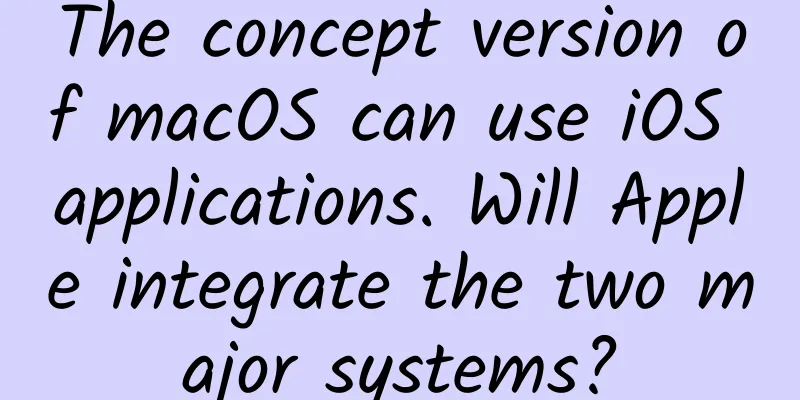The concept version of macOS can use iOS applications. Will Apple integrate the two major systems?

|
The PC market as a whole still did not recover in 2017. According to an IDC survey report, the total number of PC shipments worldwide in 2017 was 259.5 million units, down 0.2% from 260.2 million units in 2016. This number started to decline in 2011, and it continued to decline for six years. However, in 2017, Mac (Apple PC) shipments reached 19.9661 million units, an increase of 5.9% from 18.55 million units in the same period last year; market share reached 7.6%, higher than last year's 7.1%. In terms of ranking, Apple is only ranked fourth, ahead of HP, Lenovo, and Dell. In terms of shipments, the 19.9661 million units are still a long way from the top three, which have 40 to 50 million units. However, 19,966,100 units, multiplied by the high price of Mac computers, is a considerable number. According to Apple's first quarter 2018 (ending December 30, 2017) financial report, Mac revenue reached $6.895 billion. So, Mac is still very profitable. The high price does not seem to stop consumers from buying Mac. In addition to its excellent industrial design, macOS has always been an important core competitiveness of Mac. Do you still remember the "Hackintosh" that took so much effort to install? It has been more than half a year since the release of macOS High Sierra. I believe many macOS users have begun to look forward to the new version of macOS that will be released at this year's WWDC. However, based on the usual opening time of WWDC, users who want to get a glimpse of the new version of macOS will probably have to wait another three months. However, a designer recently released his own macOS 11 concept design on the Internet, which can be regarded as a little satisfying for everyone. Spanish graphic designer Álvaro Pabesio recently shared some of his concept designs for macOS 11 on the famous design community Behance. The most striking thing is that the classic status bar at the top is gone, replaced by a menu bar and status bar that are divided into two and greatly streamlined. Expand the status bar and you will see a control center similar to the iOS design. The design logic of the entire control center is basically similar to that of iOS. According to the designer's description, each control button in the control center can be further expanded through 3D Touch (on the trackpad), and the shortcut keys below can also be set independently. In addition to the status bar and control center at the top, the designer also redesigned the visuals of key applications such as Siri, Finder, and iTunes. The overall design style is very similar to iOS. In addition to the visual redesign, the designers also "added" a lot of features to macOS. First of all, this concept version of macOS 11 has an application called "Hardware", through which users can manage other devices including iPhone, iPad, Apple TV, AirPods and HomePod under the same Apple ID. In addition, a new night mode also appears on this concept version of the system. It is different from the previous night mode. It does not simply change the color tone of the entire screen, but selectively changes the color tone of elements in the application to ensure that users will not be affected when doing some work that requires accurate color display. However, what I have said before is just the appetizer. The biggest highlight of this concept version of macOS is that it will be able to run applications on iOS. And these applications are not just projection, but are optimized for desktop systems. Although it sounds incredible, this is not a feature that designers imagined out of thin air. Earlier, foreign media Bloomberg reported that Apple will add new developer tools to help developers design applications that can run on both iOS and macOS, so as to help developers more easily synchronize the development and updates of applications on iOS and macOS. Of course, we reserve our opinion on whether Apple will really take such a move to significantly weaken the dividing line between iOS devices and macOS devices. And this brings us back to an old question: Will macOS eventually merge with iOS? Since the release time of new products in different product lines of Apple is staggered, consumers often predict the new features of new products released in one product line based on the new features of new products released in another product line, such as 3D Touch and Touch ID that appeared on iPhone and MacBook Pro respectively. And given that Apple is recognized as a master in unified user experience, and people are looking forward to beautiful and new things, it is not surprising that the question "Will macOS eventually merge with iOS?" arises. It is possible to unify the user experience at the hardware level, but it is almost impossible to integrate macOS and iOS or weaken the differences between the two. The closest they came was on two devices that are both suitable for light office work: iPad Pro and MacBook. Although the two are very similar in terms of portability and light productivity, after analysis, the boundary between the two is still very clear. (Photo from: iMore) Moreover, for Apple, even weakening the differences between the two, let alone eliminating them, would do more harm than good from a business perspective. The significance of multiple product lines is that manufacturers can develop different products to meet different usage scenarios, refine various products with different positioning and functions, and thus cover a wider user group. If two products are merged and their characteristics are smoothed out, both the use value and commercial value of the products will be greatly reduced. In fact, Apple executives have responded to this question earlier. For example, Phil Schiller once said in an interview with the British Independent: iOS and macOS are two fundamentally different products. iPhones and iPads running iOS use multi-touch, and they use direct operations. Macs, on the other hand, involve a lot of cursor and menu operations, which are indirect operations. For example, the menu bar is one of the core parts of macOS, but imagine how bad the experience would be if it were placed on an iOS device. Craig Federighi also talked about this problem in an interview:
The two Apple executives mentioned the issue of interaction in their interviews. Indeed, this is where iOS and macOS differ the most. And this is also the biggest reason why the two will not be able to merge with each other. |
<<: Experience the first version of Android 9.0: Like these 6 changes
>>: How to completely clear the residual folders after uninstalling mobile APP?
Recommend
What does China National Grain and Oils Corporation say in response to the ban on outsiders bringing mobile phones into grain depots?
On the evening of August 2, the China National Gr...
What brand strategies are Coca-Cola, Durex, Forbidden City Taobao... pursuing?
There is no doubt that almost all brands are now ...
How much does it cost to be an agent for the Diqing wedding banquet mini program?
How much does it cost to be an agent of Diqing We...
How can you measure the degree of myopia by just writing a word? Why do eyes become myopic?
Are you nearsighted? Do you know how nearsighted ...
Apple is also keeping up with the times on the front end! Did you know?
At the Apple Worldwide Developers Conference (WWD...
iOS 13 shortcuts add "automation", what changes will this bring to the iPhone?
Workflow was originally a third-party efficiency ...
Why do fingers and toes turn into "prunes" when soaked in water, but other skin doesn't?
© Popular Science Leviathan Press: Every time I t...
6 steps to quickly get started with growth hacking
Growth hacking is not a new concept in China. How...
WeChat lifts 5,000 friends limit, but users can no longer view Moments
Since WeChat became a work app, the number of fri...
Even the mobile version of Chrome can't do it! Kiwi browser experience
[[439911]] Which browser do you use on your phone...
Is there always a "strange smell" in the bathroom? Most likely it's these two problems! Super easy-to-use solutions →
We have to use the bathroom every day. Perhaps th...
A brief analysis of the key points of Double 11 project operation and promotion!
When it comes to Double 11, I believe everyone is...
Why does a mosquito bite make it itch more the more I scratch it?
Audit expert: Jiang Tao Vice Chairman of the Scie...
Beware of slipping! What to do if you encounter "freezing rain" on the highway?
In the cold winter, a special meteorological phen...









